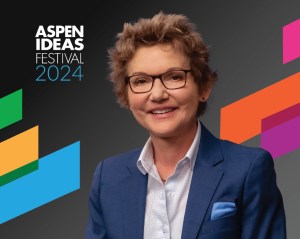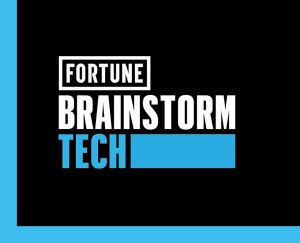Transcript
The following transcript has been edited lightly for clarity.
Jeanna Smialek:
So we are obviously at a banking conference, and so we’re primarily going to talk about banking tonight, but I would just be remiss as a journalist if I did not ask you a question about interest rates.
Mary C. Daly:
Well, luckily I’ve been doing this job long enough that I can even anticipate that you might ask me question about interest rates.
Jeanna Smialek:
If Austan Goolsbee is watching this somewhere, he’s rolling his eyes right now at me. But can you tell us a little bit about, obviously you’ve had a string of pretty good CPI reports, you’re about to go into a Fed meeting. Can you tell us about just when you’re thinking interest rate cuts might be warranted, how you’re thinking about what the hurdle is there? How are you thinking about how this all shapes up?
Mary C. Daly:
Yeah, absolutely. And you’re absolutely right. We’ve had some really good incoming data, but even with the incoming data on inflation being positive and good data after the earlier this year, we’re not there yet. We don’t have price stability right now, and we need to be very confident that we’re on a sustainable path to achieve it. On the other hand, we also have the labor market coming back into balance and we have dual mandate, price stability and full employment. And as that’s come back into balance, and if you look at historical measures, I’m a labor economist by training, we have two curves we use, the Phillips curve and the Beveridge curve. And by historical experience, we’re at this point of inflection in the labor market where additional slowing in the labor market could, it’s not a guarantee, but could cause additional increases in the unemployment rate.
So we have to keep both mandates in our mind, but again, we have to be fully confident that we’re going to be able to deliver on price stability as gently as we can. It’s a risk to act too soon to normalize interest rates and then have inflation stuck below or above rather our target. And it’s a risk to hold on too long and make the labor market falter in a way that would give people one of the two things they wanted a different one. We’d have price stability, but fewer jobs. But our goal is to really deliver on both and we’ll continue to work that way.
So what that means for interest rate cuts is that we’re data dependent. We’ll have a lot more discussion. I go and meet with my colleagues. I have two of them in the room today and one of them virtually already. And we’re not discussing that, we’re discussing banking. But when we go to the meeting in a couple of weeks, we will absolutely discuss this and craft the path of policy that we know is our best work at trying to deliver on those two mandated goals.
Jeanna Smialek:
Absolutely. And as a journalist, when I’m talking to economists right now, something that they’ll sometimes say is, “I don’t know why they don’t just get going on this. I don’t know why…” It looks like they might wait till September because unemployment is already ticking up and we know unemployment when it shoots up, it rockets. It tends to jump pretty quickly. So it seems like with inflation coming down, with unemployment going up, why not just get moving already?
Mary C. Daly:
Well, what we’ve learned from just decades and decades of experience is preemptive action or urgent action when urgency isn’t required is actually where you make mistakes. So I feel confident that we’ll deliberate this. We are already talking openly about how we see both sides of the mandate coming into better balance and that with better inflation data, you gain more confidence, but having just a little bit more confidence as opposed to full confidence, those are different things. And acting without regard for the fact that we’re not at price stability yet, and we have to be really confident that we’re going to get there.
One of the jobs, as you know from President Lorie Logan here, one of the jobs of regional Fed presidents is to travel in our districts and talk to banks and businesses and workers. And again and again, I ask, “What are you worried about?” And they’re worried about us leaving inflation stuck above 2%, and they’re worried about us hanging on for dear life until we get to 2% and tipping the labor market over. So that just tells me we have to do both and we will make the decision as we get there. So I know academic economists always want us to run fast and get there early, but I think we also have to balance the costs of acting fast and being wrong.
Jeanna Smialek:
Okay, interesting. And speaking of things that worry you, switching to bank regulation. Obviously when the Silicon Valley Bank meltdown happened last year, a lot of fingers pointed to the San Francisco Fed in particular because that bank is in your jurisdiction, it’s your supervisors who are in there. One thing that I think I and a lot of other journalists at the time were trying to sort out is just how does the San Francisco Fed interact with the Board, interact with this much bigger system when it comes to bank? And I wonder if you could just walk us through that. To what degree were you involved at SVB and how does that system work?
Mary C. Daly:
Absolutely. And it’s actually complicated if you’re outside looking in because, and it’s changed over our history. So I think it’s useful to just unpack that. So what hasn’t changed over our history is that Congress, when originally set the Fed, gave the Board of Governors the statutory responsibility for bank regulation and bank supervision. So as you know, the Board of Governors, not the Reserve Bank presidents make regulatory policy. I have no role. Lorie has no role in creating regulatory policy or voting on regulatory policy.
In addition, the Board of Governors, and at this point the vice chair of supervision since we’ve had a vice chair of supervision, makes the supervisory framework, works to determine what the supervisory framework will be, and then works with his teams in this case of people at the board, bank supervisors or supervision folks, and they set up the executing plans, how it’s going to be done across the system. Now of course, we have Reserve bank staff in all of the locations executing on the supervisory work.
And you might ask, why is it this way? And it really is meant to be a feature, and I believe it is a feature rather than a bug that we have this distributed network. So let me talk about why. First you want some centralized thought process and framework because you do not want banks in Arkansas supervised differently than banks in Texas or California or New York. You want continuity across the country because we work at a national banking market. The second thing that we want though is that for people working in the local areas who are expert in the economy and in the areas of industry, you want them to be doing active supervision because they bring expertise about what that is.
So those two things to together mean that supervision in the Federal Reserve is overseen, is created and overseen by the Board of Governors and executed by members of teams that are in each of the Reserve banks in its locations. The Reserve Bank presidents importantly don’t play a decisional role in any of these features because Reserve bank presidents are not part of this oversight that was originally set up. It is a delegated to our team’s function, but not a delegated to Reserve bank president’s function. That doesn’t mean we don’t have some things to do and contributions to make, and we make two important contributions among others.
One is we’re responsible along with our teams in the banks of fielding the people that the Board of Governors is determined it needs for us to do at good supervision. We’re responsible for making sure the skills are there and we get regular reports from board supervision oversight about where things are missing and what needs to be improved. And we’re responsible for working with the Board to help execute on that. The second thing we do, and I think this is perhaps under known, but extraordinarily important is we are out talking to banks on a regular basis, businesses, worker groups, community groups, and it’s our responsibility to bring that information back to the Board of Governors.
Now, one of the things where I think we can actually make strides to improve is to formalize that. Obviously, we have back and forth dialogues, but Lorie and I in particular and working with Governor Mickie Bowman, we’re working to try to formalize that — and Michael Barr at the Board — trying to formalize how presidents bring information back to the Board of Governors and specifically the Vice Chair of Supervision, to just make the system better. There are 12 of us. We have a lot of interaction with our communities and the banks and businesses in our communities, and bringing that information back in a formal way is quite important. We’ve long sourced information. We source it through CDIAC, and if you are a community bank, you know exactly what that is.
But we’ve done this, I’ve been working at the Fed since 1996, and I started in the research department and we always had banker roundtables, banker outreach. I attended many of them. We would go on outreach events, and I think that’s just a regular part of what Reserve Banks do. And hopefully now that we have a community banking governor, we put all that information together and we can lift the information for all sized banks, not just the ones who are the largest and located on the coasts.
Jeanna Smialek:
Okay. That makes sense.
Mary C. Daly:
Does that help?
Jeanna Smialek:
That does help. I wonder, obviously you didn’t have a ton of direct influence in what was happening at SVB, but you did have a pretty front-row seat. And I wonder from your perspective, we’ve got the OIG report now, we’ve got the Barr report, but from your perspective, from where you were sitting, what do you think went wrong in SVB’s case?
Mary C. Daly:
So I was really intrigued by our first panel’s charts and woman in the black and white, you asked a great question. We see these charts, why didn’t anybody see them? And I think what’s really interesting about all of this is any post-mortem you’d ever do about a banking crisis, you can always find charts that and things that if we’d only known they were there, we of course would’ve done something. So the lesson I think is that we really have to be forward-looking. We are very, and all regulatory and supervisory organizations, I think many institutions are like this. You look backwards and you’re really good at managing what happened before, but it’s really the risk around the corner that has to be thought of.
So what are the risks that I think we really have to focus on some areas? Well, banks are ready. I mean banking is a risk management business, and the vast majority of banks manage their risk. Well, now that’s not universal. So we have to have prudential policy that helps set some guardrails and guidelines. But one of the things that’s true is banks manage credit risk, manage liquidity risk, they manage concentration risk and manage operational risk. And you can put interest rate risk under… In my mind, you can put it under a liquidity risk and other things, but you have all those risks. What is really interesting about Silicon Valley is that we need to broaden the definition of concentration risk.
Now, I know many banks already think of this, but in the way I was originally trained in banking, it was concentration risk was sectoral concentration and geographical concentration that didn’t have diversification or some way to manage. And you might worry about deposit concentration if it was a big depositor who dominated your deposit base. But what wasn’t really regularly thought about is deposit or funding risk, that’s about four or five funders, venture capitalists, funding all of the startups who were depositing their funds there. So that means you’ve got network concentration, and that network concentration is something that ex post you can see. And then you can also do the charts that I think Steve showed where you say, “What do you have?” You’re on this quadrant of the diagram that’s at the lower right. Well, those are all tools and techniques that we have to think about.
So another thing that I think contributed to Silicon Valley Bank’s failure is growth is often thought of as a wonderful thing, but it also poses risk because second line resources don’t usually keep up with the growth of the front of the house. So just thinking about this from an operational perspective, we as supervisors and Fed supervisors and things put this forward, that’s just about doing our job in a way that looks forward.
The final thing I’ll say, and this is of course, I’m speaking for myself. I don’t usually do a disclaimer in the fireside chat, but I hope everybody knows these are my views, not anyone else in the room, especially when I have colleagues in the room. But seriously, these are my views, and I don’t have a direct role in setting supervision policy or regulatory policy.
But one of the things that I think is really important is that we don’t react by saying that the matrix of compliance cells should be even larger. Because one of the things that supervisors or anybody trying to do a compliance job, one of the challenges you have is if you spent all your time checking an ever-growing number of boxes, you don’t have enough time to step back and look at graphs like Steve looked at and Meg looked at, where you’re looking at the composite of things. Where you can really step back and say, “It’s not this risk in a silo or that risk in a silo. It’s those risks put together.” And I think that’s a real lesson that I took from this about how we go forward.
Jeanna Smialek:
That’s an interesting point because one of the things that the OIG report actually mentioned is this idea that the supervisory portion or examiner portion of SVB, they were just under-resourced. They didn’t have enough staff on it, and the examiners that were there weren’t properly trained in what to look for, what to do, or hadn’t had the kind of experience you would want for that job. I wonder, A, why did that happen in the first place? And then B, is there anything that you all are doing to change that and make sure it doesn’t happen again?
Mary C. Daly:
Again, I don’t set supervisory policy or even talk about how it’s executed or work on how it’s executed, but I can tell you how I think about it, and I’m certainly raising my hand on this as well as others are, and working collaboratively with Vice Chair Barr, and to put these things together as the presidents give all their feedback in, because it’s not just Silicon Valley Bank. I mean many banks went through stresses. Most of them actually managed those stresses, and I think that’s a remarkable component of our system. We didn’t have a panic. We didn’t have a broad scale financial issue crisis. We had banks that managed their stresses, figured out how to get through those things, and had already been managing their risks well before they got to that place.
So what can be done differently? I mean, one of the things that happens when you have really discrete thresholds that say, you’re used to be this type of bank and now you’re this type of bank, that these are very heterogeneous institutions. And a single number or single metric such as size is never really a good summary statistic for what you really have to think about. So if you would instead think of… It’s not tiering… tailoring. I think of it as tiering, but it’s also tailoring. Tailoring is the word that’s used. If you think of tailoring, I hope we don’t end up with the idea really that we should abandon tailoring because tailoring is really important.
Tailoring just says we should have a system of intensity of our supervision and regulation that fits the size and complexity and risk of the firm. But then if you’re thinking about size, complexity, and risk as the factors that would affect how you think about a bank, then those should be the metrics in part that we use to judge a bank. So instead of waiting for a bank like Silicon Valley Bank to head to LFBO status and then say, “Now, it’s under all this scrutiny.” It’s really much earlier on, it was more risky and more complex and its size was growing, you suddenly have a portfolio where you’re delivering staff earlier on in the process, which allows people to get trained on what the risks of the banks are, and you’re in better position to do that.
It’s also true that if I think about many of the community banks in my district, there are $110 billion community banks that have a simple business model are not different banks. So it’s just like, where do you put your resources? Because of course you can always endlessly grow your resources, but what we’re really needing to ask is what is the appropriate level of resources or the appropriate level of things, and what do we need to do to get people ready to manage the evolving risks of an institution?
Jeanna Smialek:
Yeah. That absolutely makes sense. And I should have followed up earlier when you were describing what happens at the regional bank level versus what happens at the national and hub and spoke level. When it comes to actually training supervisors, is that something that happens in-house at San Francisco Fed or is that something that happens national?
Mary C. Daly:
So the program of training is done at the Board of Governors and then collection. And the whole point of having training that’s uniform across the system is to ensure that you have continuity. But a lot of the hands-on day-to-day training, that’s not didactic training is done at the Reserve Banks because you need on the job training, in order to become a good supervisor, you need to watch other people get supervised. You can’t just go to a training event and then say, “Okay. Now I’m a commission or bank examiner.” It doesn’t work that way. It’s much more complicated than that. And I think ultimately that’s why the hub and spoke both work. You have to have the program set up and you have to have the material set, but then you also have to train at the local entity and work with more seasoned supervisors to do the job well.
Jeanna Smialek:
That’s good because it allows me to ask Meg Tahyar’s question from earlier, which she read up on her panel, which is she mentioned, “Why isn’t supervisory training public? Should it be public? Should we be able to see how supervisors are trained?” And I would love to know what you think about that.
Mary C. Daly:
So this is outside of my governance. So here’s how you learn how to be a good Reserve Bank President. You do not answer questions for your colleagues where you don’t have the governance. So I know, and in all seriousness, I’m trying to make, since Jeanna and I are standing in between you and the cocktail hour. But I do think importantly that one of the things that makes the Fed work is that we understand where our governance is, and where we do have authority and where we don’t have authority. So I will defer to my colleague, Michael Barr to talk through why we do or don’t do those types of things. But what I will say is that the training that we do is a collaboration across Reserve Banks and the Board of Governors.
Jeanna Smialek:
That totally makes sense. And then you talked a little bit about what you think needs to change going forward. I wonder if you could talk a little bit about what has already changed, what has changed since Silicon Valley Bank?
Mary C. Daly:
So one of the immediate things that occurred, and it’s occurred throughout the system and rightly so, is that if you recognize that things were missed and that things were there in plain sight, hiding in plain sight, I think Meg said, if they were hiding in plain sight, then we really need to use speed force and agility, as Michael Barr said. And speed force and agility, what does that look like? Speedily recognize risks, raise your hand, say them, escalate, basically. I’m not talking about escalate enforcement actions or something. I’m talking about escalate from the field staff to the team of people who would think about this so that people can understand whether this is a material or not material issue. Then the force is when there are things that are amiss or need correction, then be forceful in them early as opposed to waiting.
And then the final is to be agile. And I think that agility one is actually the hardest, and it’s in part hard because you’re trying to do this compliance job with a very large matrix of things you have to look at. But if you just simply think of back to basics and I’m literally sitting in front of Governor Bowman here, and she is a banker, not many bankers, but I’m going to say this anyway, I’ve never been a bank supervisors, but let me say this. If we get back to basics, there’s different kinds of risks that banks manage.
Supervising against those basics, then I think that just leaves our supervisors in a better position to be agile and look for risks because you’re backed up from… I think the pressure is always as more things emerge in our society, the idea is let’s put those in there. But then we end up with the potential, and I’m speaking as an economist here, but it’s the same in research as it is in banking, and I think in business is you don’t want to be a mile wide and an inch deep. You really want to focus on the core things that make for risks that are undue and manage those. And you can put many of the things that emerge on a year to year basis.
Now, as I said, I’ve been working in the bank since 1996 and there’ve been different risks over time. There were trade banks that actually when the East Asia crisis broke, this was problematic for them. There’s commercial real estate, there’s residential real estate, there’s weather, there’s this, but you can put them all in these sets of risks. And banks you find, if you talk to banks, when I talk to banks, they’re already thinking about these things and determining what are important risks for their portfolio. So for what’s changed? I think is the speed force and agility, but what really is changing is supervisors having the ability to look forward, not just look backwards and say, “Well, we’ve done that, that’s sufficient.” And what I hope is that we’ll get better and better and better. So charts like Meg’s and Steve… Well, just pointed the wrong way. Meg and Steve, that they will find that we’re looking at those beforehand and not after it at a post-mortem conference.
Jeanna Smialek:
Okay, great. We are the last thing between them and drinks. So I will wrap this up. Before I do one, I’m going to ask one final question. Sorry, don’t clap yet. Before I do, after SVB, everyone thought we were going to have a hard landing. Now it feels like maybe we’re going to have a soft landing. So to end this on an easy question-
Mary C. Daly:
Easy question. Yeah, an easy question. Are we having a soft landing?
Jeanna Smialek:
Are we going to have a soft landing?
Mary C. Daly:
So I’ll say, first of all that I never thought we were in for a recession. I mean, it’s always possible. There’s always a risk of a recession in any given year, but that was not my modal outlook, nor was it the FOMC’s modal outlook, if you look at our summary of economic projections. But importantly, I think it’s also… Really, really I want to double down on emphasis. Declaring we’re somewhere when we haven’t yet achieved it, is the recipe for not achieving it. So I am definitely not forecasting a recession, but I’m also not saying job done. We’ve got more work to do and I know my colleagues and I are committed to doing it.
Jeanna Smialek:
Is that Fed speak for, don’t jinx it?
Mary C. Daly:
Well, you said it, not me. I’ll leave on that. She can have the final word.
Jeanna Smialek:
Thank you very much.
Mary C. Daly:
Thank you.
Summary
San Francisco Fed President Mary C. Daly sat down with New York Times reporter Jeanna Smialek for a fireside chat on banking and the economy at the Exploring Conventional Bank Funding Regimes in an Unconventional World conference.
The conference was co-sponsored by the Federal Reserve Banks of Dallas and Atlanta. The conversation is available as a recording and transcript above.
From the Event
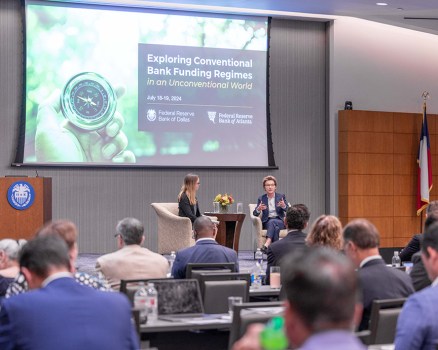
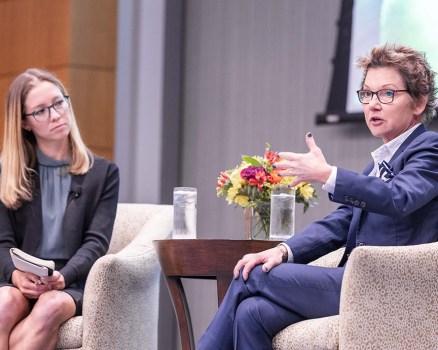

Photo credits: Federal Reserve Bank of Dallas
Sign up for notifications on Mary C. Daly’s speeches, remarks, and fireside chats.
About the Speaker
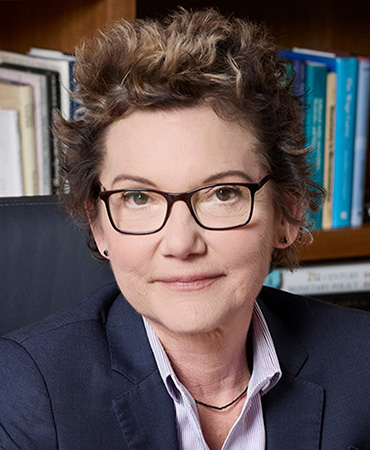
Mary C. Daly is President and Chief Executive Officer of the Federal Reserve Bank of San Francisco. In that capacity, she serves the Twelfth Federal Reserve District in setting monetary policy. Prior to that, she was the executive vice president and director of research at the San Francisco Fed, which she joined in 1996. Read Mary C. Daly’s full bio.

